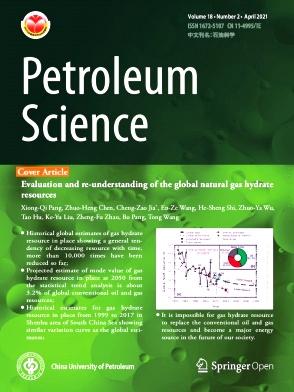Mechanical differences of laminations and crack propagation mechanism of continental shale
IF 6
1区 工程技术
Q2 ENERGY & FUELS
引用次数: 0
Abstract
Clarify the mechanical properties of different laminations and the fracture mechanism of continental shale under in-situ stress can provide theoretical basis for more comprehensive evaluation of the fracability of continental shale oil reservoir. The Chang 72 continental shale was used to investigate the mechanical properties of laminations and the effect of natural structure on the crack propagation of the shale. The XRD and thin section tests show that the laminations contain two types: bright sandy lamination with void structure and dark muddy lamination with layer structure. The real-time CT uniaxial compression tests were conducted to investigate the differences of mechanical properties between the muddy lamination and sandy lamination. It found that the uniaxial compression strength and elastic modulus of the sandy lamination are higher, forming a simple crack with large opening, and the Poisson's ratio of the muddy lamination is large, forming obvious lateral deformation and more secondary cracks. On this basis, the cuboid-shaped continental shale specimens were tested under true triaxial compression conditions to study the effect of laminations and interface cracks on crack propagation combining AE and CT techniques. It found that nascent cracks connected laminations and interface cracks to form fracture network under appropriate loading condition, tensile cracks developed in sandy lamination and shear cracks occurred in muddy lamination because of deformation dissonance and brittleness index differences, and more secondary cracks formed in muddy lamination with smaller fracture toughness. Moreover, the combination relationships between nascent and natural cracks mainly conclude direct penetration and deflection, which is affected by the filling degree and morphology of interface cracks and the relationship of lamination types. These conclusions show that laminar continental shale is conducive to forming complex fracture network, which can provide a theoretical basis for the proposal of indicators and methods for fracability evaluation.
陆相页岩层理力学差异及裂缝扩展机制
明确不同层理的力学性质和地应力作用下陆相页岩的破裂机理,可以为更全面地评价陆相页岩储层的可压性提供理论依据。以长72期陆相页岩为研究对象,研究了薄片的力学性能及自然结构对页岩裂纹扩展的影响。XRD和薄片测试结果表明,层状材料分为两种类型:具有孔隙结构的亮砂层状和具有层状结构的暗泥层状。通过实时CT单轴压缩试验,研究了泥质层状和砂质层状的力学性能差异。发现砂质层状的单轴抗压强度和弹性模量较高,形成开口较大的简单裂缝;泥质层状的泊松比较大,形成明显的侧向变形,次生裂缝较多。在此基础上,通过真三轴压缩条件下的长方陆相页岩试样试验,结合声发射和CT技术,研究层理和界面裂纹对裂纹扩展的影响。研究发现,在适当的加载条件下,新生裂缝连接层状和界面裂缝形成断裂网络,砂质层状发育拉伸裂缝,泥质层状由于变形不协调和脆性指标差异产生剪切裂缝,泥质层状形成次生裂缝较多,断裂韧性较小。新生裂纹与自然裂纹的组合关系主要为直接侵彻和挠曲,受界面裂纹填充程度、形态和层压类型关系的影响。研究结果表明,层状陆相页岩有利于形成复杂裂缝网络,可为可压性评价指标和方法的提出提供理论依据。
本文章由计算机程序翻译,如有差异,请以英文原文为准。
求助全文
约1分钟内获得全文
求助全文
来源期刊

Petroleum Science
地学-地球化学与地球物理
CiteScore
7.70
自引率
16.10%
发文量
311
审稿时长
63 days
期刊介绍:
Petroleum Science is the only English journal in China on petroleum science and technology that is intended for professionals engaged in petroleum science research and technical applications all over the world, as well as the managerial personnel of oil companies. It covers petroleum geology, petroleum geophysics, petroleum engineering, petrochemistry & chemical engineering, petroleum mechanics, and economic management. It aims to introduce the latest results in oil industry research in China, promote cooperation in petroleum science research between China and the rest of the world, and build a bridge for scientific communication between China and the world.
 求助内容:
求助内容: 应助结果提醒方式:
应助结果提醒方式:


